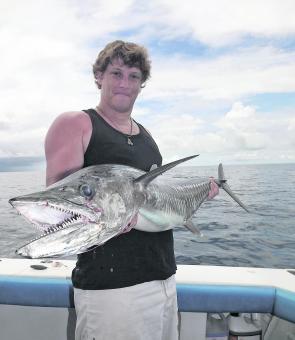The tail of the wet season definitely lingered this year, encroaching on the start of the dry season and bringing with it fresh winds and associated rain squalls on quite a few days. The upside to all this was that the currents started running to north and the water temperatures on the ocean dropped quickly, igniting the reef and mackerel species into gear.
Our winter days are best spent on the reef for guaranteed fish action when the southeasterly trade winds allow. In recent times we’ve seen the large-mouth nannygai really start to gather momentum, and substantial hauls of quality big reds have been common fare. When these fish are on the chew there’s generally a swag of other species in tow, and at times we’ve also seen serious action on the red emperor, spangled emperor (yellow sweetlip), gold-spot trevally and quite a few decent big reef mangrove jack.
Actually, the reef mangrove jack have been competing with the Spanish mackerel for floating rigs with a pilchard or a live bait attached. The Spanish have turned up in healthy numbers.
In the shallows there’s also plenty on offer, with plenty of coral trout being caught consistently in water depths from 15-25m. There’s always a host of sweetlip, moses perch, stripeys and juvenile red emperor ready to take baits as well. The turn of the high tide overall has been the most productive window when the fish seem to pile on in solid numbers.
Our light tackle scene is in full swing with the arrival of the Spanish mackerel along the coast, and there’s also other mackerel around in good figures including spotted, school and shark mackerel. Coastal inshore reefs, patches and wrecks have been holding really good numbers of these fish for the small boat brigade, and the outer reefs are producing for the more adventurous. Trolling with a combined spread of hardbody diving lures and rigged garfish is a popular way of catching mackerel, and once sourced in numbers you can have tremendous success jigging for them.
Winter time is also a great time to target big GTs. Casting poppers on the outer reefs and the tides offering more run will provide more fun. You need to concentrate on the edges of the reef which have the current pushing onto the face edge. Look for bait like fusiliers on the surface being pushed up by something bigger below, and cast across the nervous water and plug the lure back. When the tides have plenty of run the trevally are generally very aggressive towards any disturbance on the surface, and will be territorial. The only exception to this rule is directly on the full moon when for some reason they go into lockjaw mode. They will approach a lure on the surface but tend to tail slap it rather than devour it.
Nice calm days with good visibility will always enhance your ability to notice those current lines hitting the pressure points of reefs, and make spotting bait schools a lot easier. Our average GT size is around 15kg but there are always a few big brutes that will exceed the 25kg mark. Your gear has to be supreme to tame these thugs of the sea.
Closer to home our rivers and creeks are probably at their least productive for some of our prime targeted species. However, a change in tactics with some persistence will produce the goods. Live prawns or small lures are good for barra. The mangrove jack will also hit small lures but simply love a lightly weighted half pilchard or strip of mullet. The golden snapper (fingermark) will always have a strike at a juicy live sardine or small squid dangled in front of their nose.
On the other hand there are plenty of species relish the cooler conditions and there’s normally a good supply of mid-sized giant trevally and queenfish around, plus your bream, flathead, estuary cod and grunter are always opportunistic. Days that are cold, windy, dull and overcast will be tough. Those days with a bit of bright sunshine seem to put the fish in a better mood.
In saying all this, our most genuine action will occur on the Great Barrier Reef and it’s something to really look forward to if you can strike one of those picture postcard days.
Reads: 1047
The Spanish mackerel have turned up in healthy numbers.




